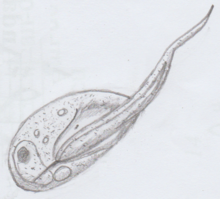
Back مونيات عديمة الأقدام Arabic Apusomonadida BS Apusomonàdids Catalan Apusomonadidae English Apusomonadida Spanish Apusomonadida Hungarian Apusomonadidae ID 아푸소모나스목 Korean Apusomonadida Portuguese 无根单胞虫科 Chinese
| Apusomonadida | |
|---|---|
 | |
| Classificazione scientifica | |
| Dominio | Eukaryota |
| (sottodominio) | Unikonta o Amorphea |
| (supergruppo) | Obazoa[1] |
| (gruppo) | Apusomonadida (Cavalier-Smith) Adl 2005 |
Gli Apusomonadida sono un gruppo di protozoi flagellati che scivolano sulle superfici e si nutrono principalmente di procarioti. Sono di particolare interesse evolutivo perché sembrano essere il gruppo gemello degli Opisthokonta, il clade che comprende sia animali che funghi.
Insieme ai Breviatea, questi formano il supergruppo Obazoa.[2][3][4]
- ^ (EN) Matthew W. Brown, Susan C. Sharpe, Jeffrey D. Silberman, Aaron A. Heiss, B. Franz Lang, Alastair G. B. Simpson e Andrew J. Roger, Phylogenomics demonstrates that breviate flagellates are related to opisthokonts and apusomonads, in Proceedings of the Royal Society of London B: Biological Sciences, vol. 280, n. 1769, 22 ottobre 2013, pp. 20131755, DOI:10.1098/rspb.2013.1755, ISSN 0962-8452, PMC 3768317, PMID 23986111.
- ^ Thomas Cavalier-Smith & Ema E. Chao, Phylogeny and evolution of Apusomonadida (Protozoa: Apusozoa): new genera and species, in Protist, vol. 161, n. 4, ottobre 2010, pp. 549–576, DOI:10.1016/j.protis.2010.04.002, PMID 20537943.
- ^ (EN) Matthew W. Brown, Susan C. Sharpe, Jeffrey D. Silberman, Aaron A. Heiss, B. Franz Lang, Alastair G. B. Simpson e Andrew J. Roger, Phylogenomics demonstrates that breviate flagellates are related to opisthokonts and apusomonads, in Proceedings of the Royal Society of London B: Biological Sciences, vol. 280, n. 1769, 22 ottobre 2013, pp. 20131755, DOI:10.1098/rspb.2013.1755, ISSN 0962-8452, PMC 3768317, PMID 23986111.
- ^ (EN) Laura Eme, Susan C. Sharpe, Matthew W. Brown e Andrew J. Roger, On the Age of Eukaryotes: Evaluating Evidence from Fossils and Molecular Clocks, in Cold Spring Harbor Perspectives in Biology, vol. 6, n. 8, 1º agosto 2014, pp. a016139, DOI:10.1101/cshperspect.a016139, ISSN 1943-0264, PMC 4107988, PMID 25085908.
